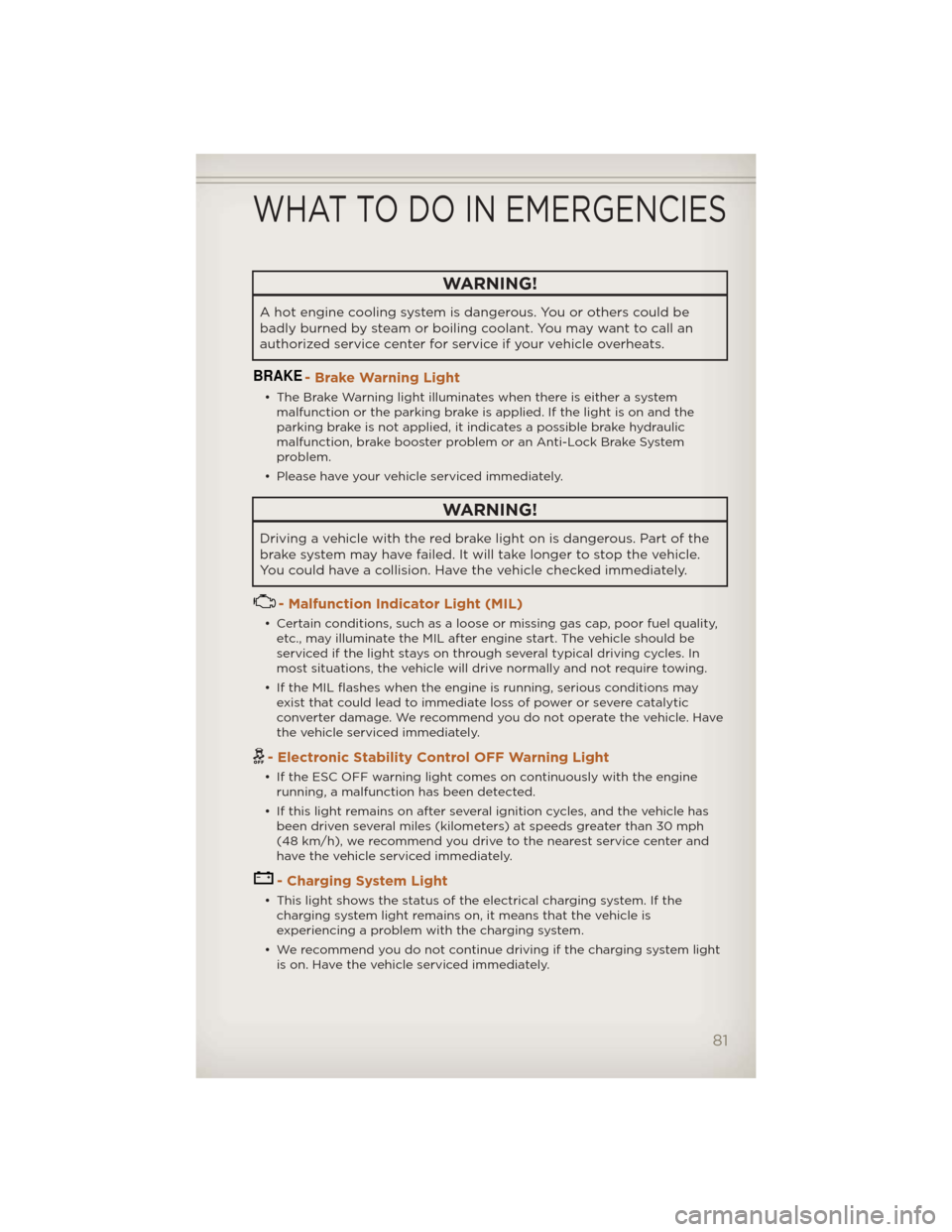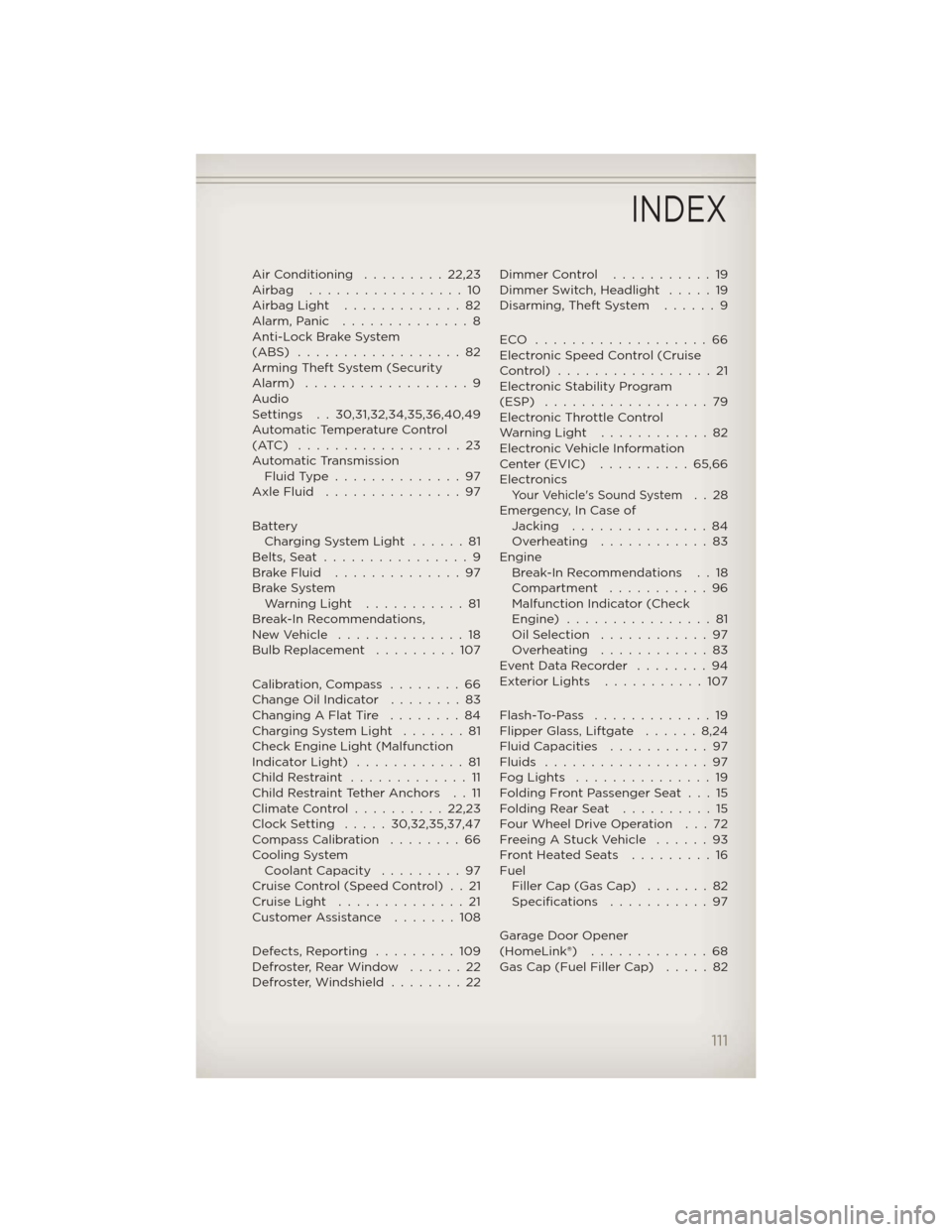charging JEEP LIBERTY 2012 KK / 2.G User Guide
[x] Cancel search | Manufacturer: JEEP, Model Year: 2012, Model line: LIBERTY, Model: JEEP LIBERTY 2012 KK / 2.GPages: 124, PDF Size: 2.92 MB
Page 8 of 124

INSTRUMENT CLUSTER
Warning Lights
- Low Fuel Warning Light
- Charging System Light**
- Oil Pressure Warning Light**
- Anti-Lock Brake (ABS) Light**
- Air Bag Warning Light**
- Electronic Throttle Control (ETC) Light
- Tire Pressure Monitoring System (TPMS) Light
- Engine Temperature Warning Light
- Transmission Temperature Warning Light
- Seat Belt Reminder Light
BRAKE- Brake Warning Light**
- Malfunction Indicator Light (MIL)**
- SERV (Service) 4WD Indicator Light
- Electronic Stability Control (ESC) Activation/MalfunctionIndicator Light*
(See page 79 for more information.)
CONTROLS AT A GLANCE
6
Page 83 of 124

WARNING!
A hot engine cooling system is dangerous. You or others could be
badly burned by steam or boiling coolant. You may want to call an
authorized service center for service if your vehicle overheats.
BRAKE- Brake Warning Light
• The Brake Warning light illuminates when there is either a systemmalfunction or the parking brake is applied. If the light is on and the
parking brake is not applied, it indicates a possible brake hydraulic
malfunction, brake booster problem or an Anti-Lock Brake System
problem.
• Please have your vehicle serviced immediately.
WARNING!
Driving a vehicle with the red brake light on is dangerous. Part of the
brake system may have failed. It will take longer to stop the vehicle.
You could have a collision. Have the vehicle checked immediately.
- Malfunction Indicator Light (MIL)
• Certain conditions, such as a loose or missing gas cap, poor fuel quality, etc., may illuminate the MIL after engine start. The vehicle should be
serviced if the light stays on through several typical driving cycles. In
most situations, the vehicle will drive normally and not require towing.
• If the MIL flashes when the engine is running, serious conditions may exist that could lead to immediate loss of power or severe catalytic
converter damage. We recommend you do not operate the vehicle. Have
the vehicle serviced immediately.
- Electronic Stability Control OFF Warning Light
• If the ESC OFF warning light comes on continuously with the enginerunning, a malfunction has been detected.
• If this light remains on after several ignition cycles, and the vehicle has been driven several miles (kilometers) at speeds greater than 30 mph
(48 km/h), we recommend you drive to the nearest service center and
have the vehicle serviced immediately.
- Charging System Light
• This light shows the status of the electrical charging system. If thecharging system light remains on, it means that the vehicle is
experiencing a problem with the charging system.
• We recommend you do not continue driving if the charging system light is on. Have the vehicle serviced immediately.
WHAT TO DO IN EMERGENCIES
81
Page 92 of 124

• Connect the opposite end of the positive (+) jumper cable to the positive(+) post of the booster battery.
• Connect the negative end (-) of the jumper cable to the negative (-) post of the booster battery.
• Connect the opposite end of the negative (-) jumper cable to a good engine ground (exposed metal part of the discharged vehicle’s engine)
away from the battery and the fuel injection system.
• Start the engine in the vehicle that has the booster battery, let the engine idle a few minutes, and then start the engine in the vehicle with the
discharged battery.
Once the engine is started, remove the jumper cables in the reverse
sequence:
• Disconnect the negative (-) jumper cable from the engine ground of the vehicle with the discharged battery.
• Disconnect the negative end (-) of the jumper cable from the negative (-) post of the booster battery.
• Disconnect the opposite end of the positive (+) jumper cable from the positive (+) post of the booster battery.
• Disconnect the positive (+) end of the jumper cable from the positive (+) post of the discharged vehicle.
• If frequent jump-starting is required to start your vehicle you should have the battery and charging system inspected at your authorized dealer.
CAUTION!
• Do not use a portable battery booster pack or any other boostersource with a system voltage greater than 12 Volts or damage to the
battery, starter motor, alternator or electrical system may occur.
• Failure to follow these procedures could result in damage to the charging system of the booster vehicle or the discharged vehicle.
• Accessories that can be plugged into the vehicle power outlets draw power from the vehicle’s battery, even when not in use (i.e.,
cellular phones, etc.). Eventually, if plugged in long enough, the
vehicle’s battery will discharge sufficiently to degrade battery life
and/or prevent the engine from starting.
WARNING!
• When temperatures are below the freezing point, electrolyte in adischarged battery may freeze. Do not attempt jump-starting
because the battery could rupture or explode and cause personal
injury. Battery temperature must be brought above the freezing
point before attempting a jump-start.
(Continued)
WHAT TO DO IN EMERGENCIES
90
Page 113 of 124

AirConditioning .........22,23
Airbag .................10
AirbagLight .............82
Alarm,Panic ..............8
Anti-Lock Brake System
(ABS)..................82
Arming Theft System (Security
Alarm) ..................9
Audio
Settings . . 30,31,32,34,35,36,40,49
Automatic Temperature Control
(ATC) ..................23
Automatic Transmission FluidType..............97
AxleFluid ...............97
Battery Charging System Light . . . . . . 81
Belts, Seat ................9
BrakeFluid ..............97
Brake System WarningLight ...........81
Break-In Recommendations,
NewVehicle ..............18
Bulb Replacement .........107
Calibration, Compass ........66
Change Oil Indicator ........83
Changing A Flat Tire . . ......84
Charging System Light . . . . . . . 81
Check Engine Light (Malfunction
IndicatorLight) ............81
ChildRestraint .............11
Child Restraint Tether Anchors . . 11
ClimateControl..........22,23
Clock Setting .....30,32,35,37,47
Compass Calibration . . . . . . . . 66
Cooling System Coolant Capacity .........97
Cruise Control (Speed Control) . . 21
CruiseLight ..............21
Customer Assistance . . . . . . . 108
Defects, Reporting .........109
Defroster, Rear Window . . . . . . 22
Defroster, Windshield . . . . . . . . 22 Dimmer Control . . . . . . . . . . . 19
Dimmer Switch, Headlight . . . . . 19
Disarming,TheftSystem ......9
ECO ...................66
Electronic Speed Control (Cruise
Control) .................21
Electronic Stability Program
(ESP) . . . . . .
............79
Electronic Throttle Control
WarningLight ............82
Electronic Vehicle Information
Center (EVIC) . . . . . . . . . . 65,66
Electronics
Your Vehicle's Sound System..28
Emergency, In Case of Jacking . . . . . . . . . . . . . . . 84
Overheating ............83
Engine Break-In Recommendations . . 18
Compartment . . . . . . . . . . . 96
Malfunction Indicator (Check
Engine) . . . . . . . . . . . . . . . . 81
OilSelection ............97
Overheating ............83
EventDataRecorder ........94
ExteriorLights ...........107
Flash-To-Pass .............19
Flipper Glass, Liftgate . . . . . . 8,24
Fluid Capacities . . . . . ......97
Fluids ..................97
FogLights ...............19
Folding Front Passenger Seat . . . 15
FoldingRearSeat ..........15
Four Wheel Drive Operation . . . 72
Freeing A Stuck Vehicle . . . . . . 93
Front Heated Seats . . . . . . . . . 16
Fuel Filler Cap (Gas Cap) . . . . . . . 82
Specifications . . . . . . . . . . . 97
Garage Door Opener
(HomeLink®) . . . . .........68
Gas Cap (Fuel Filler Cap) . . . . . 82
INDEX
111